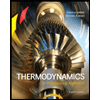
Concept explainers
Which is a more valuable resource for work production in a closed system −15 ft3 of air at 100 psia and 250°F or 20 ft3 of helium at 60 psia and 200°F? Take T0 = 77°F and P0 = 14.7 psia.
The more valuable resource for work production in a closed system; air or helium.
Answer to Problem 29P
The air has the more valuable resource for work production in a closed system.
Explanation of Solution
Express the mass in the system.
Here, mass is
Express the entropy change between the given state and dead state.
Here, entropy change between the given state and dead state is
Express the specific volume at the given state.
Express the specific volume at dead state.
Express the specific closed system exergy.
Here, specific internal energy is
Express the total exergy available for the production of work.
Here, mass is
Conclusion:
Solve for AIR:
Refer Table A-1E, “molar mass, gas constant and critical point properties”, and write the gas constant of air.
Refer Table A-2E, “ideal gas specific heats of various common gases”, and write the properties of air.
Substitute
Substitute
Substitute
Substitute
Substitute
Substitute
Solve for HELIUM:
Refer Table A-1E, “molar mass, gas constant and critical point properties”, and write the gas constant of helium.
Refer Table A-2E, “ideal gas specific heats of various common gases”, and write the properties of helium.
Substitute
Substitute
Substitute
Substitute
Substitute
Substitute
On comparing the total exergy available for the potential of work from Equations (VII) and (VIII), it is obtained that air has more potential.
Hence, the air has the more valuable resource for work production in a closed system.
Want to see more full solutions like this?
Chapter 8 Solutions
Thermodynamics: An Engineering Approach
- Steam enters an adiabatic turbine at 2.5MPa pressure and 450C, and at 60kPa pressure and 100C. comes out. If the power output of the turbine is 3MW, the mass flow and the isentropic efficiency of the turbine calculate.arrow_forwardAir is compressed in an adiabatic compressor from 55 psia and 660 R to 270 psia and 1200 R. Calculate the isentropic efficiency of the compressor. Type your answer in the first box.arrow_forwardDetermine the compressor work input required to compress steam isentropically from 100 kPa to 1 MPa, assuming that the steam exists as (a) saturated liquid and (b) saturated vapor at the inlet statearrow_forward
- If saturated liquid steam at 850 kPa is throttled to 120 kPa, what is the quality of the resulting steam?arrow_forwardOne hundred kg of saturated steam at 100 kPa is to be adiabatically compressed in a closed system to 1000 kPa. How much work is required if the isentropic compression efficiency is 90 percent?arrow_forwardSteam at a pressure of 1000 psia and 650 0F enters an adiabatic turbine and leaves at 65 psia. The isentropic efficiency of the turbine is 73 %. Calculate the power produced by the turbine per unit of mass in BTU/lbm. Type your answer in the first box.arrow_forward
- The turbines in steam power plants operate essentially under adiabatic conditions. A plant engineer suggests ending this practice. She proposes to run cooling water through the outer surface of the casing to cool the steam as it flows through the turbine. This way, she reasons, the entropy of the steam will decrease, the performance of the turbine will improve, and as a result the work output of the turbine will increase. How would you evaluate this proposal?arrow_forwardSteam at 4 MPa and 350°C is expanded in an adiabatic turbine to 120 kPa. What is the isentropic efficiency of this turbine if the steam is exhausted as a saturated vapor?arrow_forwardSteam in an adiabatic turbine expands from 4 MPa and 450°C to 0.1 MPa with a flow rate of 6 kg / s. If steam leaves the turbine as saturated steam, what will be the power output of the turbine?arrow_forward
- Steam in an adiabatic turbine expands at a pressure of 6 MPa and a temperature of 450 ° C to a pressure of 0.1 MPa with a flow rate of 6 kg / s. If steam leaves the turbine as saturated steam, what will the power output of the turbine be?arrow_forwardAn inventor claims to have invented an adiabatic steady-flow device with a single inlet-outlet that produces 230 kW when expanding 1 kg/s of air from 1200 kPa and 300°C to 100 kPa. Is this claim valid?arrow_forwardRefrigerant-134a at 1600 kPa and 80°C is expanded adiabatically in a closed system to 100 kPa with an isentropic expansion efficiency of 85 percent. Determine the second-law efficiency of this expansion. Take T0 = 25°C and P0 = 100 kPa.arrow_forward
 Elements Of ElectromagneticsMechanical EngineeringISBN:9780190698614Author:Sadiku, Matthew N. O.Publisher:Oxford University Press
Elements Of ElectromagneticsMechanical EngineeringISBN:9780190698614Author:Sadiku, Matthew N. O.Publisher:Oxford University Press Mechanics of Materials (10th Edition)Mechanical EngineeringISBN:9780134319650Author:Russell C. HibbelerPublisher:PEARSON
Mechanics of Materials (10th Edition)Mechanical EngineeringISBN:9780134319650Author:Russell C. HibbelerPublisher:PEARSON Thermodynamics: An Engineering ApproachMechanical EngineeringISBN:9781259822674Author:Yunus A. Cengel Dr., Michael A. BolesPublisher:McGraw-Hill Education
Thermodynamics: An Engineering ApproachMechanical EngineeringISBN:9781259822674Author:Yunus A. Cengel Dr., Michael A. BolesPublisher:McGraw-Hill Education Control Systems EngineeringMechanical EngineeringISBN:9781118170519Author:Norman S. NisePublisher:WILEY
Control Systems EngineeringMechanical EngineeringISBN:9781118170519Author:Norman S. NisePublisher:WILEY Mechanics of Materials (MindTap Course List)Mechanical EngineeringISBN:9781337093347Author:Barry J. Goodno, James M. GerePublisher:Cengage Learning
Mechanics of Materials (MindTap Course List)Mechanical EngineeringISBN:9781337093347Author:Barry J. Goodno, James M. GerePublisher:Cengage Learning Engineering Mechanics: StaticsMechanical EngineeringISBN:9781118807330Author:James L. Meriam, L. G. Kraige, J. N. BoltonPublisher:WILEY
Engineering Mechanics: StaticsMechanical EngineeringISBN:9781118807330Author:James L. Meriam, L. G. Kraige, J. N. BoltonPublisher:WILEY





